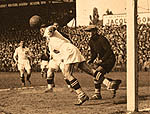
Finally, in 1863, developments reached a climax. At Cambridge University, where in 1848 attempts had already been made by former pupils from the various schools to find a common denominator for all the different adaptations of the game, a fresh initiative began to establish some uniform standards and rules that would be accepted by everyone. It was at this point that the majority spoke out against such rough customs as tripping, shin-kicking and so on. As it happened, the majority also expressed disapproval at carrying the ball. It was this that caused the Rugby group to withdraw. They would probably have agreed to refrain from shin-kicking, which was in fact later banned in the Rugby regulations, but they were reluctant to relinquish carrying the ball. This Cambridge action was an endeavour to sort out the utter confusion surrounding the rules. The decisive initiative, however, was taken after a series of meetings organised at the end of the same year (1863) in London. On 26 October 1863, eleven London clubs and schools sent their representatives to the Freemason’s Tavern. These representatives were intent on clarifying the muddle by establishing a set of fundamental rules, acceptable to all parties, to govern the matches played amongst them. This meeting marked the birth of The Football Association. The eternal dispute concerning shin-kicking, tripping and carrying the ball was discussed thoroughly at this and consecutive meetings until eventually on 8 December the die-hard exponents of the Rugby style took their final leave. They were in the minority anyway. They wanted no part in a game that forbade tripping, shin-kicking and carrying the ball. A stage had been reached where the ideals were no longer compatible. On 8 December 1863, football and rugby finally split. Their separation became totally irreconcilable six years hence when a provision was included in the football rules forbidding any handling of the ball (not only carrying it). Only eight years after its foundation, The Football Association already had 50 member clubs. The first football competition in the world was started in the same year – the FA Cup, which preceded the League Championship by 17 years.
International matches were being staged in Great Britain before football had hardly been heard of in Europe. The first was played in 1872 and was contested by England and Scotland. This sudden boom of organized football accompanied by staggering crowds of spectators brought with it certain problems with which other countries were not confronted until much later on. Professionalism was one of them. The first moves in this direction came in 1879, when Darwin, a small Lancashire club, twice managed to draw against the supposedly invincible Old Etonians in the FA Cup, before the famous team of London amateurs finally scraped through to win at the third attempt. Two Darwin players, the Scots John Love and Fergus Suter, are reported as being the first players ever to receive remuneration for their football talent. This practice grew rapidly and the Football Association found itself obliged to legalise professionalism as early as 1885. This development predated the formation of any national association outside of Great Britain (namely, in the Netherlands and Denmark) by exactly four years. After the English Football Association, the next oldest are the Scottish FA (1873), the FA of Wales (1875) and the Irish FA (1880). Strictly speaking, at the time of the first international match, England had no other partner association against which to play. When Scotland played England in Glasgow on 30 November 1872, the Scottish FA did not even exist – it was not founded for another three months. The team England played that day was actually the oldest Scottish club team, Queen’s Park. The spread of football outside of Great Britain, mainly due to the British influence abroad, started slow, but it soon gathered momentum and spread rapidly to all parts of the world. The next countries to form football associations after the Netherlands and Denmark in 1889 were New Zealand (1891), Argentina (1893), Chile (1895), Switzerland, Belgium (1895), Italy (1898), Germany, Uruguay (both in 1900), Hungary (1901) and Finland (1907). When FIFA was founded in Paris in May 1904 it had seven founder members: France, Belgium, Denmark, the Netherlands, Spain (represented by the Madrid FC), Sweden and Switzerland. The German Football Federation cabled its intention to join on the same day. This international football community grew steadily, although it sometimes met with obstacles and setbacks. In 1912, 20 national associations were already affiliated to the Fédération Internationale de Football Association (FIFA). By 1925, the number had increased to 39, in 1930 – the year of the first World Cup – it was 46, in 1938, 52 and in 1950, after the interval caused by the Second World War, the number had reached 68. Today, FIFA comprises 204 member associations in the four corners of the globe. They comprise around 305,000 clubs – over 223,000 of which in Europe alone -, and more than 1,548,000 teams with around 246 million people who regularly play football.
Copyright and Source: FIFA History of the Game |
Soccer History Part 4
















